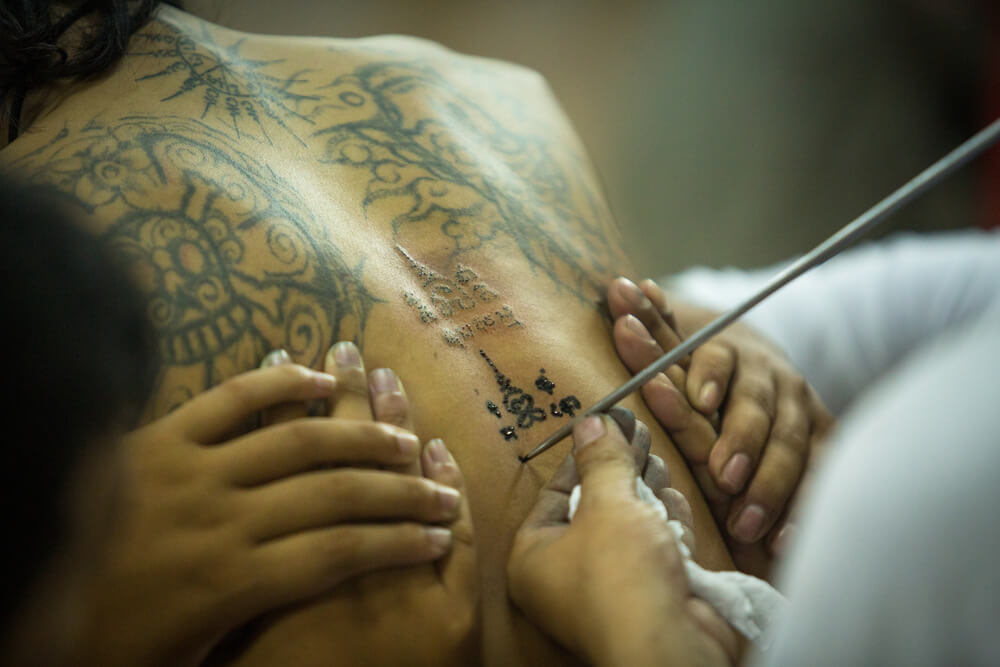Buddhism is not restrictive when it comes to acquiring a tattoo. They believe everything is temporary, including the body and tattoos. So getting a tattoo doesn’t abuse Buddhist doctrines.
Monks believe that tattoos are deeply rooted in their spirituality. They argue that their forefathers practiced tattooing, so it is only right they preserve the practice as a form of overcoming pain.
The sacred tattoos that these monks acquire are called Sak Yant. No need to worry as I will expound on Sak Yant further.
About Sak Yant Tattoo
Yant is a geometric pattern, and Sak means to tap. The Sak Yant pattern is tattooed onto your skin using ancient bamboo.
Sak Yant tattoo art originated in Asia about a thousand years ago. It came about as a substitute for taking protective ornaments to battle. Warriors would get the Sak Yant tattoo as an alternative inked in their bodies as a protective charm.
The tattoos are aesthetically appealing and comprise animal, sacred, deity, and Pali designs. Other than for art, Sak Yant tattoos are believed to give you good luck, protection, love, power, et cetera.
They are popular among monks, and senior monks who have mastered the art of administering them also do the tattooing in temples.
Types of Sak Yant Tattoos for Monks
1. Ha-that
Ha-that means five rows, and you tattoo it at the back of your left shoulder, with five lines representing five various blessings for good luck and success.
The first line represents protection in your residential place and unfair court cases.
The second line prevents and reverses bad omens, karma, or misfortune.
The third row offers protection against curses and witchcraft.
The fourth is believed to provide success and good luck in all your endeavors.
The fifth line acts as a love potion by making you physically appealing when looking for an intimate partner.
2. Gao York
The Gao Yord tattoo is believed to be the master Sak Yant tattoo. You should be tattooed along your spine. Gao is interpreted as nine in Thai lingo.
The symbolism of Yao differs as one faction believes its 9 peaks mean the 9 peaks of mount Neru, a sacred mountain among Buddhists considered the epicenter of spiritual and physical universes.
Another faction claim that Gao represents 9 peaks that mean levels of your rise to enlightenment and Nirvana.
Gao yard is believed to give you protection from harm, evil thoughts, and violence.
3. Paed Tide
Paid Tide is an 8-directional yant tattoo that is believed to protect monks when they are traveling.
It has eight points that look like the sun and stand for eight cardinal points of the universe. Inside the circle is the Kata that will offer protection when traveling.
4. Unalome
Unalome tattoo has a straight line that represents not giving up on your path to greatness and enlightenment.
Its zigzag curves symbolize the tribulations of life as you strive to reach enlightenment.
It also has a portion, like a crown of the head, specific to Arahants saints.
5. Lord Buddha
Lord Buddha’s tattoo is made up of 3 oval drawings representing Buddha. Buddha Sak Yant’s tattoo design can be inked by itself, but it is often adorned with other Yants.
6. Twin Tigers
Twin tigers are the strongest Sak Yant design. Tigers are potent animals found at the top of the food chain.
Monks who live dangerously get twin tiger tattoos which they believe will enable them to gain authority and protection.
Frequently Asked Questions
1. Is It Appropriate To Get a Tattoo of Buddha?
Conservative Buddhists and monks don’t entertain the idea of tattooing Buddha as they consider tattooing his head on your body blasphemous.
More modernized Buddhists, on the hand, don’t mind tattooing Buddha on their bodies. They consider it an honor to tattoo their god on their bodies.
2. Are Women Allowed To Get Sak Yants?
You can get a Sak Yant tattoo at tattoo shops, but women can’t be tattooed in a temple where competent monks are tattooists. Some monks who are liberal may tattoo you as a woman outside the temple.
But what monks won’t do is tattoo women near their breasts.
3. Which Body Parts Are Prohibited from Tattooing Sak Yants?
From ancient times to date, most Sak Yant and Buddhist tattoos are prohibited being placed below your waistline.
Although men are allowed to ink some tattoos, especially sexually related ones, on their thighs. Women are not given that privilege.
Conclusion
Tattoos and Buddhism go hand in hand to the point that they get inked as a form of spirituality and connection to their gods.
As I have highlighted above, Sak Yant tattoos are the most significant to monks, and they get them for various spiritual symbolism.
Please go through the above content to familiarize yourself with more in regards to Buddhism and tattoos, and I am confident you will learn a lot.














